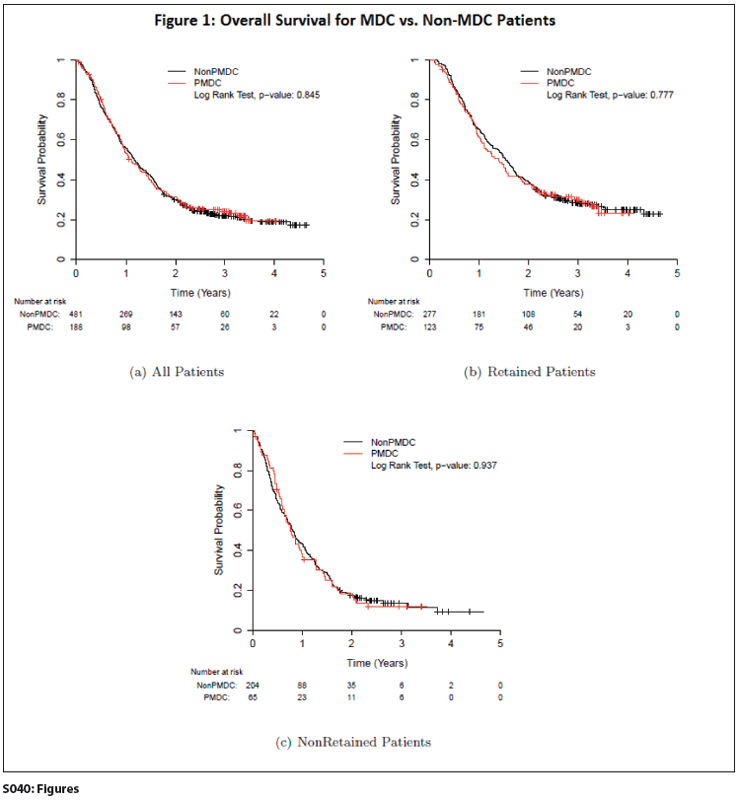(S040) Outcomes, Costs, and Patient Satisfaction in a Pancreatic Multidisciplinary Clinic: Can Multidisciplinary Oncology Models Deliver Higher Value Care?
For patients with pancreatic cancer, we compared direct care costs, patient retention rates, and survival outcomes for patients treated in our institution’s pancreatic multidisciplinary clinics (MDCs) with those evaluated within the institution but outside the MDC.
S040: Figures

Shereef M. Elnahal, MD, MBA, Aaron T. Wild, BA, Katherine Y. Fan, BS, Hao Wang, PhD, Brandon Luber, SCM, Avani S. Dholakia, BS, Terry Langbaum, Timothy M. Pawlik, MD, PhD, Christopher L. Wolfgang, MD, Joseph M. Herman, MD, MSc; Johns Hopkins University School of Medicine; Johns Hopkins Hospital
Background: Multidisciplinary clinics (MDCs) are novel delivery models for disease-based oncologic care. MDCs involve simultaneous initial evaluation by three oncologic specialists, radiologists, pathologists, and others. The costs and overall value (defined as quality relative to costs) of care delivered in MDCs are not well described. For patients with pancreatic cancer, we compared direct care costs, patient retention rates, and survival outcomes for patients treated in our institution’s pancreatic MDC with those evaluated within the institution but outside the MDC.
Methods: Two groups of patients with pancreatic cancer were analyzed and compared retrospectively: patients evaluated in a pancreatic MDC versus through individual referrals. Demographics, region of origin, disease stage, and patient retention rates (defined as > 3 encounters for pancreatic cancer, a surrogate for patient satisfaction) were collected using electronic health records. Cost information was obtained using claims data and stratified by inpatient, outpatient, physician, OR, pharmaceutical, radiology, and lab charges and compared using Fisher’s exact tests. Logistic regression was used to compare retention rates between MDC and non-MDC patients, correcting for region of origin, disease stage, and demographics. Cox proportional hazards models facilitated comparisons of hazard ratios (HRs) of death, correcting for similar variables. Kaplan-Meier curves compared long-term survival between the two groups.
Results: Between 2008 and 2010, 252 consecutive MDC patients were compared with 764 consecutive non-MDC patients (total n = 1,100). Gender was similar between the groups. MDC patients were slightly older (64 vs 62 y; P = .02). A greater percentage of MDC patients traveled from nonadjacent states (49% vs 23%, P < .001) and had more advanced disease stages (10%, 25%, and 23% of MDC patients with borderline resectable, locally advanced, and metastatic disease, respectively, vs 5%, 9%, and 18% of non-MDC patients). Adjusting for demographics, disease stage, and region of origin, MDC patients had 2.816 times the odds of being retained over non-MDC patients (P < .001). Mean total charges per patient were higher for non-MDC patients than MDC patients ($58,458 vs $43,318, P < .001), and all cost subcategories were statistically higher for non-MDC vs MDC patients except for outpatient charges ($19,762 vs $22,606, P = .612). Across all patients, the non-MDC group had a higher HR for death than the MDC group, trending toward but not reaching statistical significance (HR = 1.182; P = .117); this difference remained non-significant after stratifying by patient retention status. At 3 years, unadjusted overall survival (OS) rates were approximately 20% for both MDC and non-MDC patients (log-rank test P = .845); differences also remained nonsignificant after stratifying by patient retention status (Figure).
Conclusions: Even after adjusting for region of origin, patients who were evaluated in the MDC were more likely to continue their care at our institution, suggesting higher patient satisfaction for MDCs. Mean costs per patient were higher for non-MDC patients, even despite lower retention rates. Outpatient costs were higher for MDC patients, suggesting that greater outpatient engagement in MDCs can supplant more costly inpatient encounters. Because survival outcomes were similar for both groups despite higher costs for non-MDC patients, these data suggest that multidisciplinary models offer higher-value care for patients with pancreatic cancer.
Proceedings of the 96th Annual Meeting of the American Radium Society - americanradiumsociety.org
Targeted Therapy First Strategy Reduces Need for Chemotherapy in Newly Diagnosed LBCL
December 7th 2025Lenalidomide, tafasitamab, rituximab, and acalabrutinib alone may allow 57% of patients with newly diagnosed LBCL to receive less than the standard number of chemotherapy cycles without compromising curative potential.